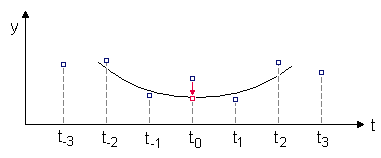 You are working with the text-only light edition of "H.Lohninger: Teach/Me Data Analysis, Springer-Verlag, Berlin-New York-Tokyo, 1999. ISBN 3-540-14743-8". Click here for further information.
You are working with the text-only light edition of "H.Lohninger: Teach/Me Data Analysis, Springer-Verlag, Berlin-New York-Tokyo, 1999. ISBN 3-540-14743-8". Click here for further information.
 You are working with the text-only light edition of "H.Lohninger: Teach/Me Data Analysis, Springer-Verlag, Berlin-New York-Tokyo, 1999. ISBN 3-540-14743-8". Click here for further information. You are working with the text-only light edition of "H.Lohninger: Teach/Me Data Analysis, Springer-Verlag, Berlin-New York-Tokyo, 1999. ISBN 3-540-14743-8". Click here for further information.
|
Table of Contents  Bivariate Data Bivariate Data  Smoothing Smoothing  Savitzky-Golay Filter Savitzky-Golay Filter |
|
| See also: mathematical details, coefficients |   |
One approach for smoothing the time series is to replace each value of the series with a new value which is obtained from a polynomial fit to 2n+1 neighboring points (including the point to be smoothed), with n being equal to, or greater than the order of the polynomial.

Example: smoothing a time series by using a 2nd order polynomial and 7 data points. The equation for this particular Savitzky-Golay smoothing is defined as follows:
yt = (-2xt-3 + 3xt-2 + 6xt-1 + 7xt + 6xt+1 + 3xt+2 - 2xt+3)/21.
The figure below shows the smoothing results (lower trace) for a spiked,
noisy sine signal (upper trace), using a second order polynomial fit with
25 data points. In order to experiment with different smoothing methods,
click at the image below.
Last Update: 2006-Jšn-17